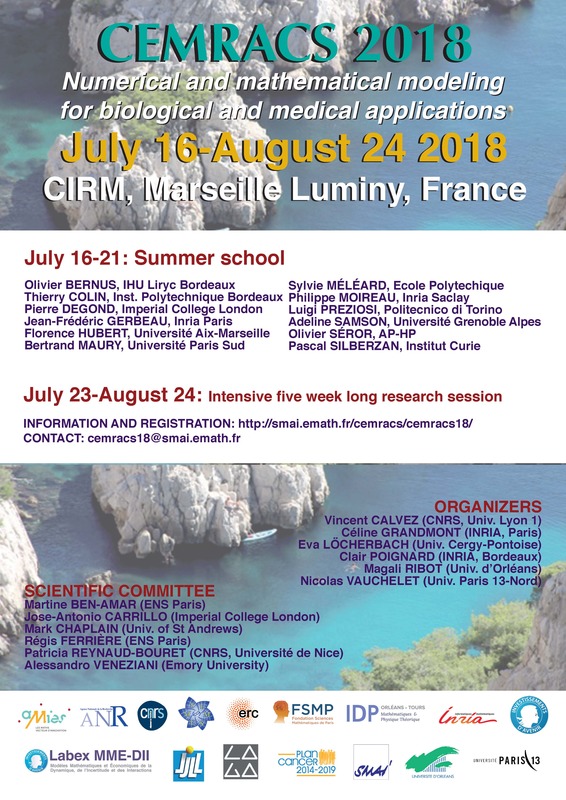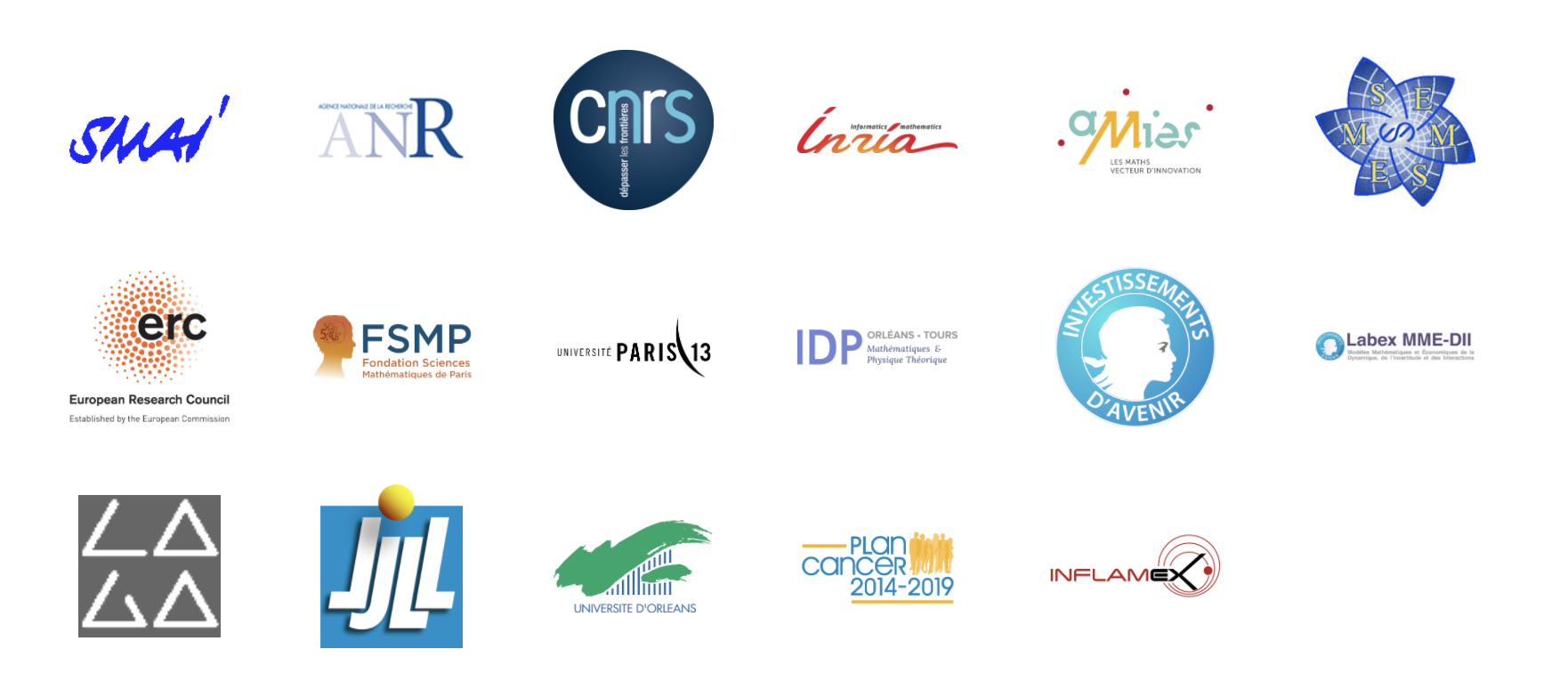Advanced research in scientific calculation or Centre d’Eté Mathématique de Recherche Avancée en Calcul Scientifique
Numerical and Mathematical Modeling for Biological and Medical Applications: Deterministic, Probabilistic and Statistical Descriptions
Modélisation numérique et mathématique pour la biologie et la médecine : descriptions déterministes, probabilistes et statistiques
16 July – 24 August 2018
|
Scientific Committee
Comité scientifique Martine Ben-Amar (ENS Paris) |
|
|
The CEMRACS is a scientific event of the SMAI (the French Society of Applied and Industrial Mathematics). The concept was initiated in 1996 by Yvon Maday and Frédéric Coquel and takes place every year at CIRM in Luminy (Marseille, France) during 6 weeks from mid-july. The goal of this event is to bring together scientists from both the academic and industrial communities to work and discuss on focused topics.
During the first week, a classical summer school is proposed. It consists of several lectures given by leading scientists and related to the topics of the research projects. The remaining 5 weeks are dedicated to working on the research projects, possibly after a morning seminar. CEMRACS’18 will be the twenty-third of the series. The aim of this CEMRACS is to focus on the mathematical models applied to natural sciences. For several years, application of mathematics to biology or medicine has become a major field of interest. Important progresses have been made in multiscale and multiphysics modeling, for both theoretical and numerical aspects. These simulations can be viewed as an alternative to in vivo or in vitro experiments and may be referred to as in silico experiments. A major advantage of these in silico experiments is that they do not require invasive procedures and can be easily used to elaborate/test different scenarii. The contribution of mathematical and numerical models to research and development in the biomedical field can be at several levels. In a first step, this may provide valuable tools to understand/explain the underlying biomedical phenomena or the observations. In a second step, it can also help to make a prediction (for tumor growth, drug efficiency,…). Finally, it can be integrated as a part of the decision process as an optimization tool.
|
Le CEMRACS (Centre d’Eté Mathématique de Recherche Avancée en Calcul Scientifique) a été initié par Yvon Maday et Frédéric Coquel en 1996. Il se déroule chaque été en deux phases. La première phase consiste en une semaine de cours et la deuxième en une période de cinq semaines de recherche sur projet au CIRM, à Luminy. Lors de la deuxième phase, chaque participant travaille en équipe sur un projet proposé soit par un industriel soit par une équipe universitaire. Les équipes sont constituées de jeunes chercheurs encadrés par un ou deux chercheurs confirmés.
Le but de ce CEMRACS est de s’intéresser aux modèles mathématiques appliqués aux sciences naturelles. Depuis plusieurs années, l’application des mathématiques à la biologie ou la médecine est devenue un sujet de première importance. D’importants progrès ont été faits du côté de la modélisation multi-échelle et multi-physique, du point de vue théorique et numérique. Ces simulations peuvent être vues comme des alternatives aux expériences in vivo ou in vitro et prennent le nom d’expériences in silico. Un avantage majeur de ces expériences in silico est qu’elles ne nécessitent pas de techniques invasives et qu’elles peuvent être utilisées pour élaborer ou tester différents scénarii. La contribution des modèles mathématiques et numériques à la recherche et au développement dans le domaine biomédical peut se faire à plusieurs niveaux. Tout d’abord, la modélisation peut fournir des outils fiables pour comprendre ou expliquer les phénomènes biologiques sous-jacents ou les observations. Une deuxième étape permet de faire des prédictions (de croissance de tumeur, d’efficacité de médicaments, etc…). Enfin, les modèles, en tant qu’outils d’optimisation, peuvent être intégrés comme faisant partie du processus de décision. Le but de ce CEMRACS est d’aller plus loin dans les interactions entre la communauté mathématique et les acteurs biomédicaux : biologistes, physiciens, ingénieurs biomédicaux, pharmacologistes,… et de favoriser de nouvelles collaborations entre les mathématiciens appliqués et les chercheurs industriels et biomédicaux. |
Pierre Degond (Imperial College London) Modeling emergence in biology (pdf_1) (pdf_2) (pdf_3)
Jean-Frederic Gerbeau (INRIA Paris) Cardiac electrophysiology: modeling, simulation and industrial application (pdf_1) (pdf_1bis) (pdf_2)
Florence Hubert (Aix-Marseille Université) Introduction to pharmacokinetics and pharmacodynamics of anticancer drugs (pdf)
Nathalie Krell (Université Rennes 1) When PDMP naturally appear to model biological problems (grow of bacteria, interacting spiking neurons)
Bertrand Maury (Université Paris Sud)
Sylvie Méléard (Ecole Polytechnique). Stochastic dynamics for adaptation and evolution of microorganisms (pdf)
Philippe Moireau (INRIA Saclay) Inverse problem and data assimilation for applications in biology and medecine (pdf_1) (pdf_2)
Luigi Preziosi (Politecnico di Torino) Multi-level mathematical models for cell migration in dense fibrous environment (pdf)
Olivier Seror (Inserm Hopital Jean Verdier, Université Paris 13) Irreversible electroporation a new opportunity of curative treatment for HCC patients not amenable to thermal ablations (pdf)
Week July 23-27
Benoit Fabrèges (Université Lyon I) Introduction to Python
Annabelle Collin (Université deBordeaux )
Yannick Privat (Sorbonne Université)
Sebastien Martin (Université Paris 5)
Gael Raoul (CNRS, Ecole Polytechnique)
Romain Yvinec (Inra Tours) (pdf)
Week July 29-August 3
Marie Postel (Sorbonne Université)
Christèle Etchegaray (Institut Mathématiques Toulouse)
Bérénice Grec (Université Paris Descartes) Macroscopic and kinetic diffusion models for gaseous mixtures in the context of respiration (pdf)
Diane Peurichard (Inria)
Emmanuel Maitre (Université Grenoble Alpes) Diffusion redistanciation schemes, Willmore problem and red blood cell (pdf)
Week August 6-10
Simon Labarthe (INRA)
Silvia Bertoluzza (IMATI Pavia)
Sébastien Imperiale (INRIA)
Magali Tournus (Ecole Centrale Marseille)
Hélène Hivert (Ecole Centrale Lyon)
Week August 13-17
Bastien Polizzi (Univeristé Nice Sophia-Antipolis)
Eva Loecherbach (Université Cergy-Pontoise)
Olivier Gallinato (INRIA & IMB)
Laurent Boudin (Sorbonne Université & Inria)
Project presentation – August Wednesday 22 and Thursday 23
Multiscale population dynamics: interactions between scales in developmental and reproductive biology (pdf)
Cell aggregation and segregation (pdf)
Horizontal gene transfer (pdf)
Modelling of adipocytes dynamics (pdf)
Estimation of liver conductivities for irreversible electroporation (pdf)
Interface reconstruction for 2D compressible multi-materials flows (pdf)
Optimal release of mosquitoes to control dengue transmission (pdf)
Mathematical modelling of cell migration (pdf)
Influence of the mode of reproduction on species invasion (pdf)
Stochastic Dynamics of Confined Microswimmers (pdf)
Mathematical Modeling of Spatial Propagation of AB oligomers (pdf)
Modeling and simulation of deformable bodies in low-Reynolds flows (pdf)
Construction of a Machine Learning tool based on Differential Equations integrated into a dynamic tree allowing biological data assimilation (pdf)
Geometry description and mesch construction from medical imaging (pdf)
A multiscale epidemic model of Salmonella infection (pdf)
Size-varying respiratory aerosols modeling (pdf)



